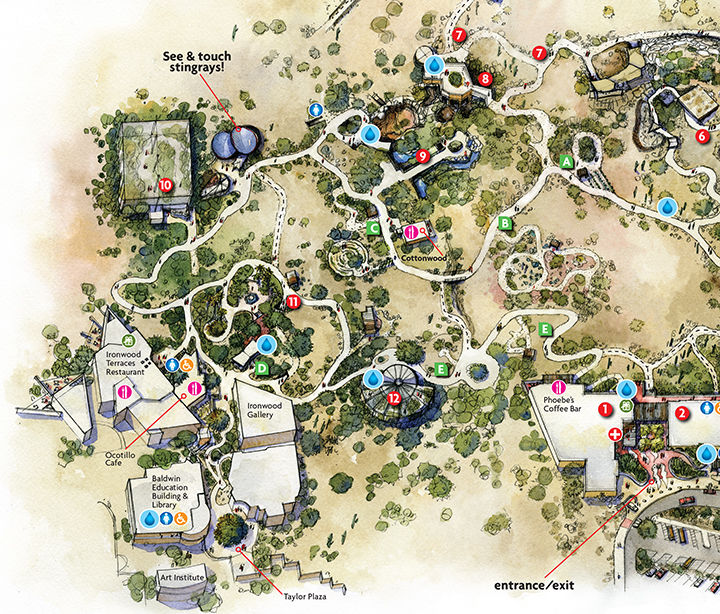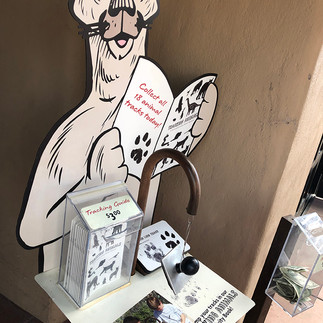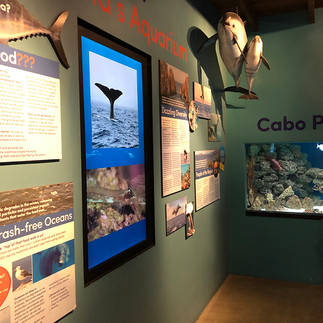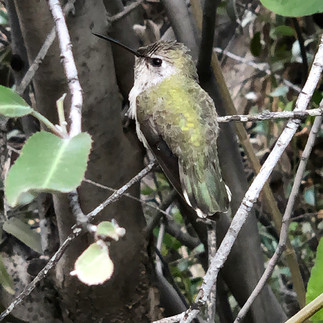
If you are visiting Tucson, definitely make a trip out to this lovely 98-acre oasis just west of Tucson. The Arizona-Sonora Desert Museum classifies themselves as everything under the sun, from a botanical garden, art gallery, aquarium, and natural history museum. I would say they are a botanical garden and a small conservation zoo. Their animals are all rescue animals that can't go back into their natural habitats for various reasons, but primarily due to not surviving. Most of the animals are from the local region, but there are some from neighboring environments. The park sits out west of Tucson and is reachable once you pass through the Tucson state park. The Tucson state park is a beautiful place to stop, hike, and catch a view of the city and the desert plain.
It was founded in 1952 by William Carr. He wanted to create a unique presentation of a region in a park-like setting and help preserve that region through education and research. From there, they reached out to the local community and some key figures that wanted to learn more about this ecosystem to preserve it. This museum has had a significant impact on the development of Tucson as a city and has had an influence in the planning to reduce light pollution, preserving the environment in a developing town, and conserve water to maintain the beauty of the Sonoran desert.
The park you see today was an effort that started in the 1990s to develop the habitats of the animals further and increase the paths and foliage represented to the visitors in the park. They wanted to present to the public the knowledge they had gained over the last forty years. They also wanted people to be aware of the habitats and ecosystems that were slowly disappearing and giving hope to preserve these environments.
The parking can be limited on a crowded day, so get there early. The morning is also the best time to see the outdoor animals in action. The ticket counter is to the left of the entrance, with friendly docents and volunteer staff to help you get started. It is a quiet outside park with trails leading to lots of natural outdoor animal habitats and atriums. The paths wind and cross, so make sure you grab a map to avoid missing anything. It is easy to get turned around. From the entrance, the trails lead down a gentle slope. It is easily accessible by wheelchair with a few exceptions where you need to watch for signs to follow the correct path.
Tucson's weather is more moderate than many other parts of Arizona. It is primarily outside, so visiting when the temperature outside is mild is best. There isn't much shelter out on the trails from the hot desert sun, so bring a refillable water container. There is a counter-service restaurant and a sit-down restaurant down the path to the left from the entrance. Also, to the left, there is a coffee shop available for a quick snack. The coffee shop is much closer than the restaurants. The food amenities are at the entrance, and once you enter the park, the services dwindle, which is why the refillable water container comes in handy. Of course, we bribed our kids with ice cream before we took off down the paths.
Immediately you are captivated by the entrance buildings and their small indoor aquarium, Warden Aquarium, to the left and their Reptile, Invertebrate, and Amphibian Hall to the right. These are a great jumping-off point with their peek-a-boo windows that peer into the animals' world. These are part of the original offerings at the museum. They have been well maintained and updated over the years to accompany the many creatures that crawl, jump, and swim through the Sonoran Desert. Outside these two buildings are docents that work with a few friends that would like to say hello. Before heading out to the outdoor exhibits and atriums, make sure you pick up the Animal Tracking Stations book. It is a fun way for the kids to interact with the exhibits and familiarize themselves with tracks that trace across the sands of the Sonoran Desert.
We landed up, heading to the left through the intermingled paths that direct you to the many atriums with butterflies and birds. The hummingbird atrium was our first atrium experience, and who isn't fascinated by the incredible lightness of the hummingbird. The hummingbirds will be zipping and whizzing through the air inches from your head. Then for a split second, they are still. Atriums are beautiful places to experience birds and to watch them soar and interact. A lot of the desert birds match the terrain and are hard to spot in this environment. You will need to take a moment and stand still to catch a glimpse of them. Before we hit our second atrium with much larger birds that fill the skies of the Sonoran Desert, we took a look at the burrowing animals in Life Underground. You may find another docent hanging with a familiar friend to have an up-close encounter. Next to the Birds of the Sonoran Desert is a touch pool full of Sting-rays to admire.
The next region of the museum is filled with large animals that dominate the various terrains of Arizona and those along the Pacific Coast. One of our first encounters was the bighorn sheep climbing the walls of the exhibit. It is an awe-inspiring skill that they have traversing these steep inclines. Some critters live in the water, and you can travel down below to get a closer look through the plexiglass. Otters are always crowd-pleasers and never seem to be done with their day.
As you head through the Riparian Corridor and into the Cat Canyon, you start to see some fun predators like the ocelot and bobcat. These are smaller cats, but they know how to survive. The path leads to the Desert Loop Trail and Desert Grassland that holds multiple species that are very familiar throughout the Southwest territory. It is lovely how the park twists and turns you through each environment and physically isolates each species but visually ties them together with their creative rock formations. Life on the Rooks in the Desert Loop Trail has some fantastic rock formations that will have your kids crawling up and through to get their taste of living amongst the rocks.
There are landscaped gardens that fill the pathways and introduce the foliage of various regions. The abundance of beauty that extends from these gardens is juxtaposed against the desert that surrounds the museum. At the edge of the landscaped park, a path leads you down into the natural environment surrounding the museum. Right next to this path is an indoor play area for kids called Packrat Playhouse. It has a significant adventure climb, crawl, and slide area surrounded by facts about packrats and a smaller cushioned area for the smaller children not ready to climb through the landscape.
Next, we return to the larger predators that you can find among the hills and mountains of Arizona and throughout most of the Southwest. The Mountain Woodland has large impressive exhibits that hold mountain lions, black bears, and Mexican gray wolves. Most of the day, they lounge in peace, but as their instincts kick in during the dusk and dawn, you see them begin to pace and bounce. Appropriately placed next to this exhibit is the Ancient Arizona & Sonorasaurus exhibit. Here is where you can learn about the raptors that still fill our skies and the ones that once inhabited the Sonoran Desert millions of years ago.
As we headed out, we passed by a lovely large amphitheater and an exhibit and cave dedicated to what lies beneath the rock formations in Arizona. It is a great way to introduce your children to an underground experience. It is an easy first step before you plan a trip to visit a cave deep below the earth. You can learn how they will handle the situation, and it may not be for you, or it could be a wonderful surprise.

Tel 520.883.2702
Winter Hours: October - February 8:30 am - 5:00 pm
Summer Hours: March - June 7:30 am - 5:00pm; July - September 7:30 am - 2:00pm
Age: Pre-school and up, strollers are welcome through the experience.
There aren't any fast-find discounts to the park, and they don't belong to an association that provides discounts to other zoos and museums. There are discounts for seniors and those that have served our country. There are also children's prices, but the adult price starts at 13 years of age. It is a park that will take multiple visits to appreciate, and because of its established landscape and architecture, it is well worth the visit. It is easy to order tickets on-line.
It is best to stay on the trails and not enter the arboretums if you have a kid with sensory issues, apprehensive, or anxious about entering buildings. There is a lot to see without entering the buildings. This museum is a place you will want to come back and visit if you have a kid that loves to be outdoors and spend time with animals. The location of the museum naturally creates a quiet environment. Take pictures or videos of what is inside each arboretum or hall, and then take them outside to your child to show them what they will see inside. It is all about the unknown and making them feel comfortable. The more they learn, the more they will trust what is on the other side of the door. Don't forget to bring distraction toys, headphones, or whatever you need to get through the day. It may be a long day if the weather is beautiful.
Images from: Two Weeks A Year and Arizona-Sonora Desert Museum
#autismtravel #adhd #sensoryissues #autismacceptance #autismawareness #anxietydisorder #autism #specialneedstravel #arizonasonoradesertmuseum #asdm #zoo #arizona #tucson #botancialgarden #aquarium #twoweeksayear


























































































Comments